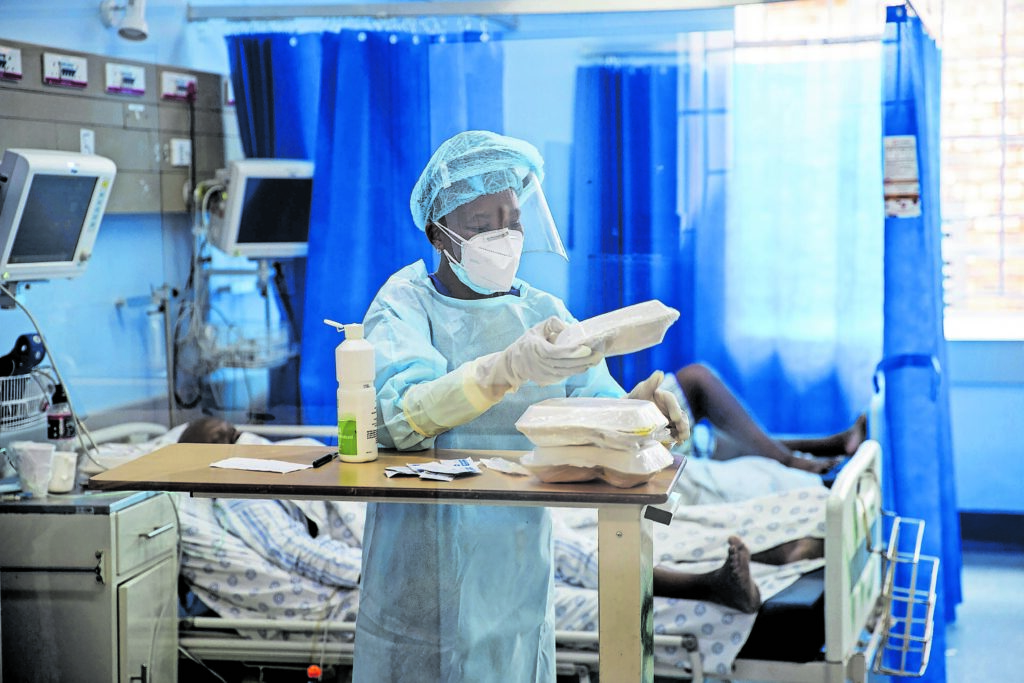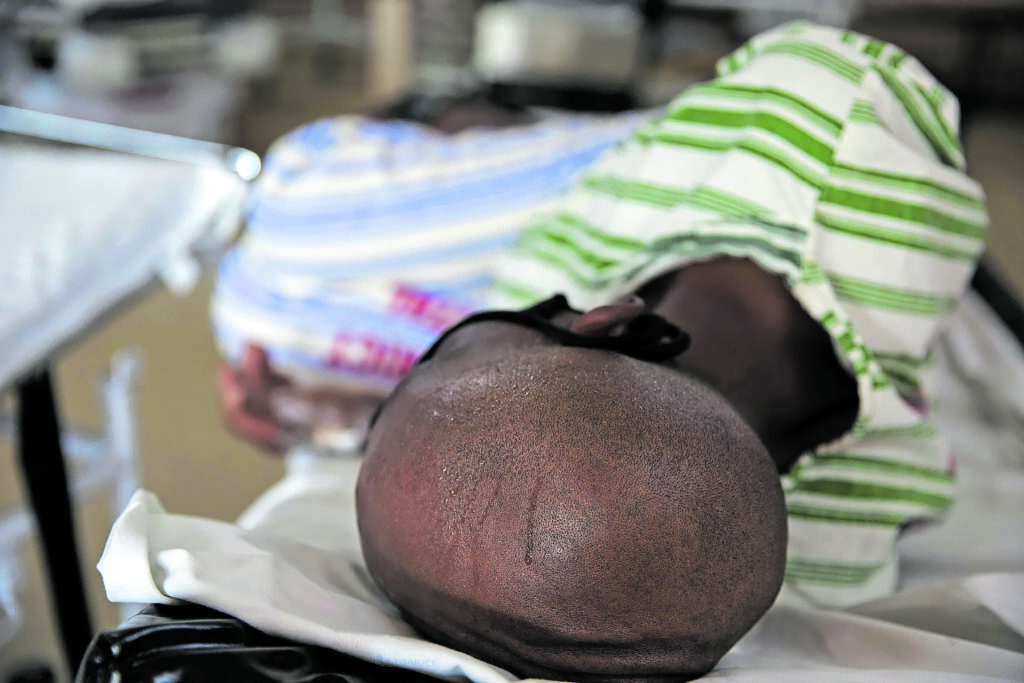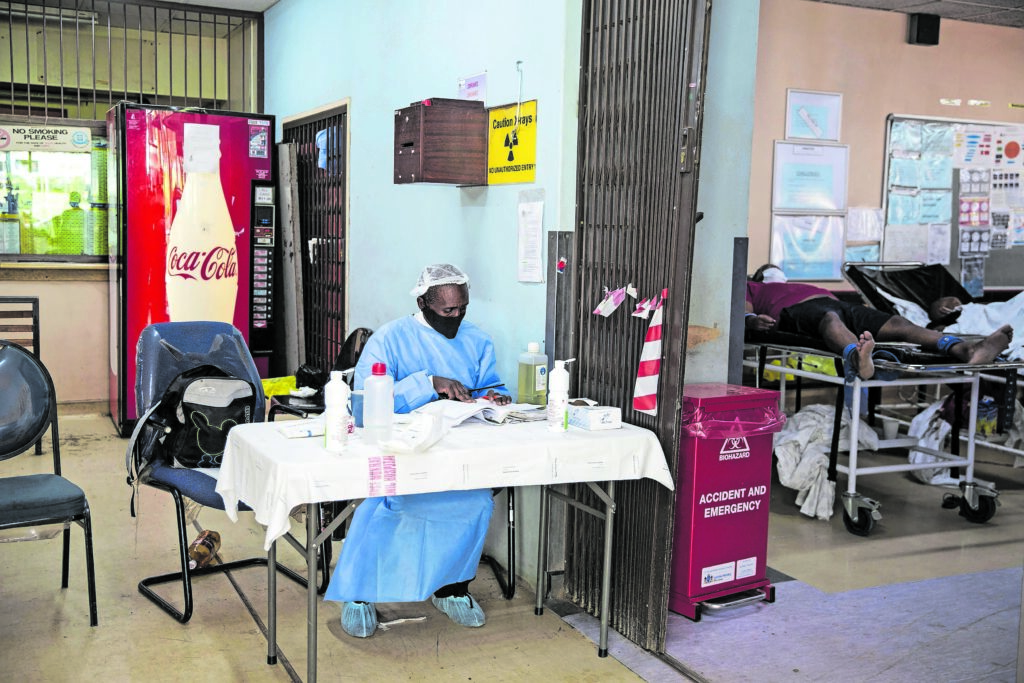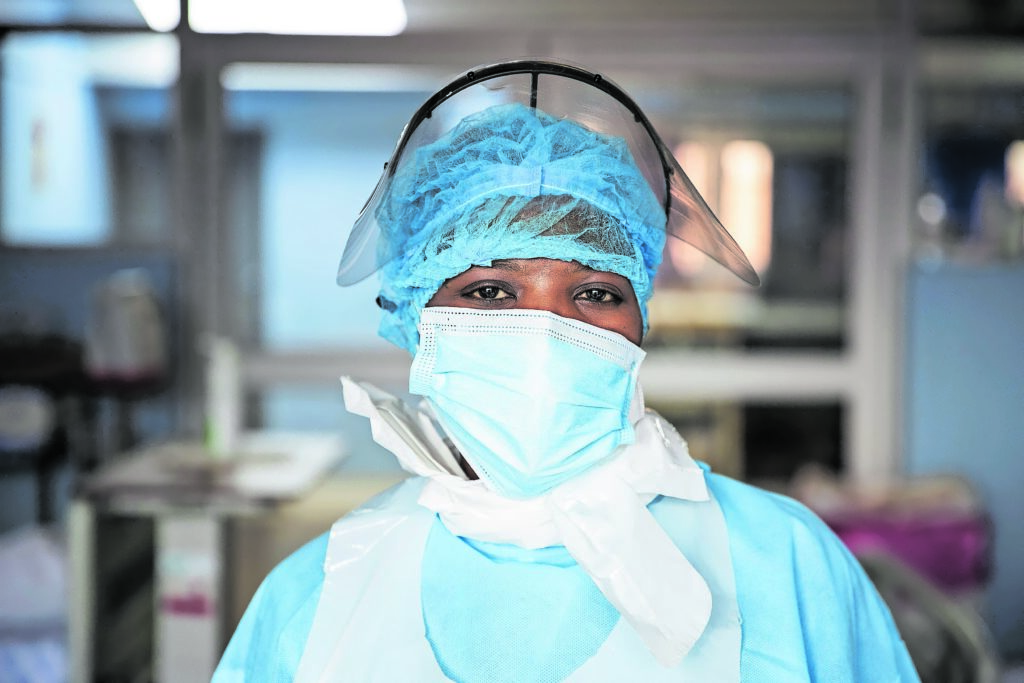Staff nurse Lenah Lefifi is a mother of two. She has been tending to the six patients in her isolated Covid-19 ward for four hours already. All of them are on oxygen. Lefifi has another two hours to go before she can take a break. She says: “Please write with big letters: WE NEED MORE STAFF. I’ve been in here since 7 am. I haven’t been able to eat yet.” (James Oatway)

The City of Tshwane, the municipal area in which George Mukhari academic hospital is situated, is a Covid-19 hotspot. The hospital lies next to Ga-Rankuwa, a sprawling labyrinth of settlements that stretch to the border of the North West province, and serves a population of about 1.7-million people. We arrived at George Mukhari late morning on January 15 and spent time in the Covid-19 wards, including the intensive care unit, until late afternoon.
 Increased intensity: A nurse in a Covid-19 isolation ward at the George Mukhari hospital gives her patients their meals. Healthworkers say it almost feels as if they’re dealing with a different virus during the second wave. There are far more patients and deaths, and the disease seems more intense. (James Oatway)
Increased intensity: A nurse in a Covid-19 isolation ward at the George Mukhari hospital gives her patients their meals. Healthworkers say it almost feels as if they’re dealing with a different virus during the second wave. There are far more patients and deaths, and the disease seems more intense. (James Oatway)
 A patient receives oxygen in an isolated room in one of the Covid-19 wards. Covid-19 treatment at George Mukhari Academic Hospital in Ga-Rankuwa, north of Pretoria. South Africa. (James Oatway)
A patient receives oxygen in an isolated room in one of the Covid-19 wards. Covid-19 treatment at George Mukhari Academic Hospital in Ga-Rankuwa, north of Pretoria. South Africa. (James Oatway)
 Faster spread: A patient with Covid-19 symptoms (above) waits for
treatment. Because the new variant spreads faster than the original
virus, there have been more hospitalisations during the second wave.
But the 501V.2 variant doesn’t make people sicker: we’re seeing more
deaths and hospitalisations in the second wave because there are so
many more cases; however, the proportion of deaths in relation to the
total number of cases is not higher than during the first wave; a security
guard (right) mans a desk at the accident and emergency ward entrance.
It’s cramped, hot, poorly ventilated and resembles something like a
traffic jam. There’s no room for proper social distancing. (James Oatway)
Faster spread: A patient with Covid-19 symptoms (above) waits for
treatment. Because the new variant spreads faster than the original
virus, there have been more hospitalisations during the second wave.
But the 501V.2 variant doesn’t make people sicker: we’re seeing more
deaths and hospitalisations in the second wave because there are so
many more cases; however, the proportion of deaths in relation to the
total number of cases is not higher than during the first wave; a security
guard (right) mans a desk at the accident and emergency ward entrance.
It’s cramped, hot, poorly ventilated and resembles something like a
traffic jam. There’s no room for proper social distancing. (James Oatway)
 Security at the entrance of the Accident and Emergency ward. Covid-19 treatment at George Mukhari Academic Hospital in Ga-Rankuwa, north of Pretoria. South Africa. (James Oatway)
Security at the entrance of the Accident and Emergency ward. Covid-19 treatment at George Mukhari Academic Hospital in Ga-Rankuwa, north of Pretoria. South Africa. (James Oatway)
 Wave of chaos: ‘This second wave is chaotic. It’s worse than the first wave. Our wards are
always full,’ says staff nurse Lenah Lefifi. ‘I’m afraid of getting the virus. We wear our PPE
[personal protective equipment]. It’s all we can do.’ Would she take a vaccine? ‘I’m not
sure. It’s very new,’ she says. (James Oatway)
Wave of chaos: ‘This second wave is chaotic. It’s worse than the first wave. Our wards are
always full,’ says staff nurse Lenah Lefifi. ‘I’m afraid of getting the virus. We wear our PPE
[personal protective equipment]. It’s all we can do.’ Would she take a vaccine? ‘I’m not
sure. It’s very new,’ she says. (James Oatway)
 ‘Infectious bodies’: The accident and emergency ward is packed, but the staff insist it’s a quiet day. Patients are
lying or sitting on gurneys with oxygen pipes attached to their noses and drips attached to their wrists (above).
Oxygen suppliers say they are struggling to keep up with high demand for medical-grade oxygen; a porter
wheels a gurney with a body tightly wrapped in plastic and covered in a green sheet out of the back (right). He
will take it to the mortuary, which currently has plenty of space. The body will be placed
in a special, cordoned-off section marked ‘infectious bodies’. (James Oatway)
‘Infectious bodies’: The accident and emergency ward is packed, but the staff insist it’s a quiet day. Patients are
lying or sitting on gurneys with oxygen pipes attached to their noses and drips attached to their wrists (above).
Oxygen suppliers say they are struggling to keep up with high demand for medical-grade oxygen; a porter
wheels a gurney with a body tightly wrapped in plastic and covered in a green sheet out of the back (right). He
will take it to the mortuary, which currently has plenty of space. The body will be placed
in a special, cordoned-off section marked ‘infectious bodies’. (James Oatway)
 Mental health concerns: Mpho Kunene is the operational
manager of George Mukhari’s Covid-19 wards. She makes sure there
are enough staff and equipment. She says: ‘We were badly prepared for
the first wave — we didn’t have wards for isolation. We just nursed the
patients wherever we could. Thankfully, we’ve had renovations done for
the second wave … But we don’t have enough psychological support. It’s
difficult coming to work when you hear that a colleague has passed.’ (James Oatway)
Mental health concerns: Mpho Kunene is the operational
manager of George Mukhari’s Covid-19 wards. She makes sure there
are enough staff and equipment. She says: ‘We were badly prepared for
the first wave — we didn’t have wards for isolation. We just nursed the
patients wherever we could. Thankfully, we’ve had renovations done for
the second wave … But we don’t have enough psychological support. It’s
difficult coming to work when you hear that a colleague has passed.’ (James Oatway)
 The body of a patient who was suspected to have died as a result of Covid-19 is removed from the Accident and Emergency ward. Covid-19 treatment at George Mukhari Academic Hospital in Ga-Rankuwa, north of Pretoria. South Africa. (James Oatway)
The body of a patient who was suspected to have died as a result of Covid-19 is removed from the Accident and Emergency ward. Covid-19 treatment at George Mukhari Academic Hospital in Ga-Rankuwa, north of Pretoria. South Africa. (James Oatway)
This story was produced by the Bhekisisa Centre for Health Journalism. Sign up to its newsletter